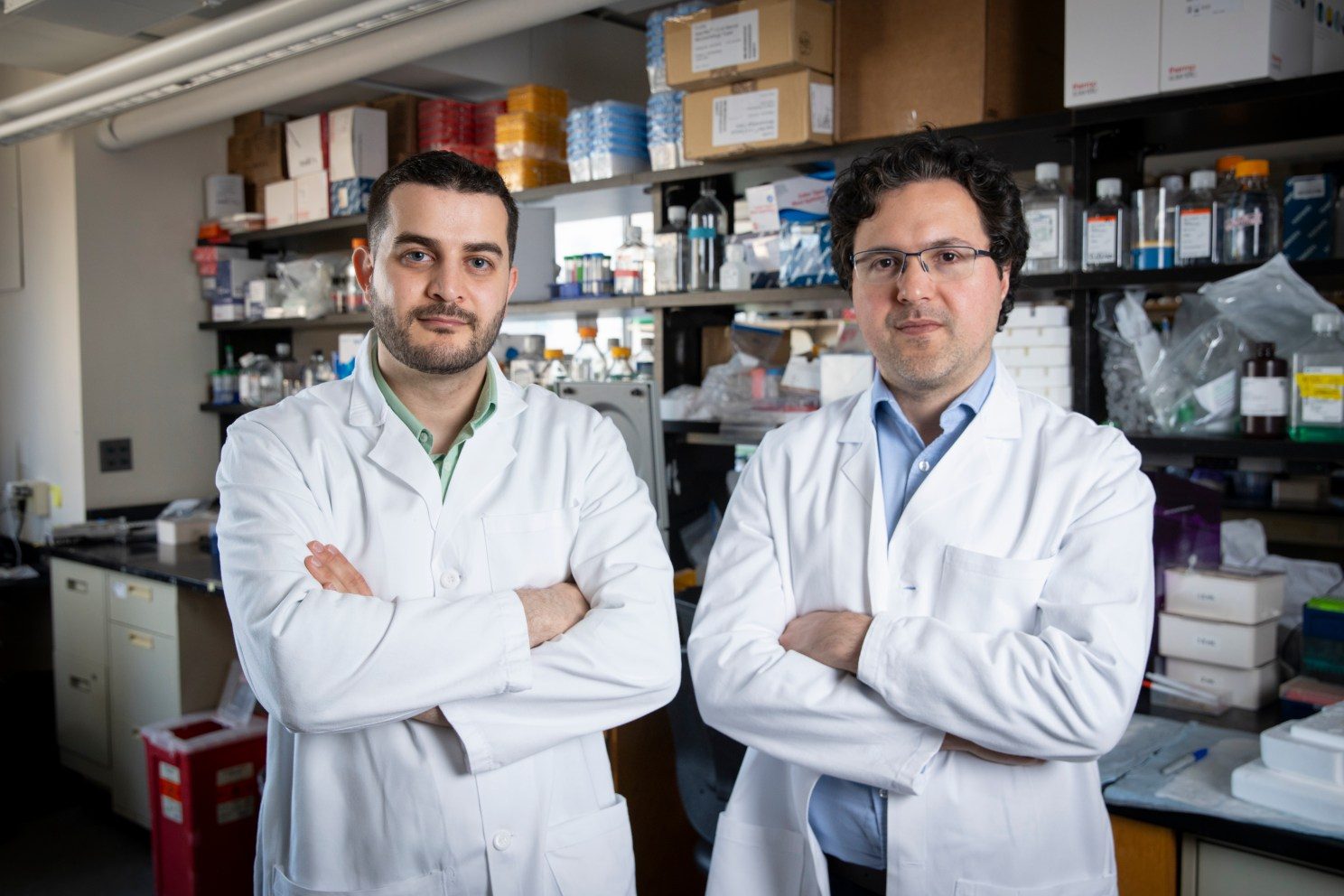Taha Rakhshandehroo (left) and Mohammad Rashidian in their lab.
Niles Singer/Harvard Staff Photographer
Health
Fixing key flaw in revolutionary cancer treatment
Researchers devise way to boost CAR T-cell therapy to potentially ensure it doesn’t fade prematurely
Researchers from Harvard Medical School and the Dana-Farber Cancer Institute have figured out how to give a timely boost to a revolutionary treatment that enlists immune cells in the anticancer fight, potentially bypassing a flaw that allows the therapy to fade before all diseased cells are gone.
The researchers, Mohammad Rashidian, assistant professor of cancer immunology at Dana-Farber and radiology at HMS, postdoctoral fellow Taha Rakhshandehroo, and their team created an enhancer protein that selectively energizes the anticancer cell therapy called CAR T-cells. This protein not only boosts the cells’ anticancer activity, it also promotes the development of memory CAR T-cells, which provide long-term immune protection against cancer, similar to the immune response after chicken pox infection or vaccination.
The cancer treatment, CAR-T cell therapy, was approved by federal regulators in 2017. It works by extracting immune T-cells from patients and reprograming them with a “chimeric antigen receptor” (CAR) on the cell surface. The receptor works like a lock and key for a protein marker on the surface of the cancer cells. That allows the CAR T-cells to recognize and attack cancer cells once they’re infused back into the body.
In recent years, CAR T-cell therapy has made headlines by working where conventional treatments failed, in some cases completely clearing cancer cells from the sickest patients.
But once the CAR T-cells have cleared most of the cancer, their numbers fade over time, allowing any remaining diseased cells to proliferate. For example, in multiple myeloma, a cancer of white blood cells, CAR T-cell therapy increases patients’ survival over the short term, but half of patients relapse within one to two years. Within three years, most patients see their cancers recur.
The advance, which has yet to be tested in humans, was developed using models of multiple myeloma in preclinical mice studies in work sponsored by Dana-Farber’s Innovation Research Fund Award, the Parker Institute for Cancer Immunotherapy, and a Blavatnik Therapeutics Challenge Award.
Results of the study were published recently in the journal Nature Biotechnology. The researchers said the procedure should be useful against other cancers, and have studies underway testing it against leukemia and lymphoma.
CAR T-cell therapy is one of a suite of relatively recent cancer treatments that have revolutionized care. Unlike traditional surgery, chemotherapy, and radiation therapy, the therapy turns the body’s own immune system into a powerful weapon to fight the disease.
The enhancer protein devised by Rashidian and Rakhshandehroo selectively targets CAR T-cells, enhancing their activity and persistence. The pair began the work two years ago with the goal of developing a procedure that could quickly translate to clinical care.
Other researchers have been addressing the CAR T-cell longevity problem for a decade by focusing on re-engineering them to extend their lifespan in the body, a strategy that largely fell short. Instead, Rashidian and Rahkshandehroo focused on stimulating the CAR-T cells post-infusion and at a desired time, rather than altering them.
To do so, they designed a protein that targets and stimulates CAR T-cells. The CAR receptor is the engineered part of the CAR T-cell that allows it to recognize cancer cells by detecting a specific marker on them.
The enhancer protein fuses the cancer marker to a molecule called IL-2, which enhances T-cell activity and persistence. The IL-2 is engineered to be weak so it does not affect normal T-cells, thus avoiding toxicities. However, because the enhancer protein targets CAR T-cells, the weak IL-2 enhances their activity through proximity.
“Sometimes in science, you see marginal differences here and there, and then you do the statistics, and you find out the significance,” Rakhshandehroo said. “For us, it was like night and day. Once we saw it, we knew there was something very robust happening here.”
Rakhshandehroo said subsequent experiments were aimed at illuminating specific questions about the process, but what impressed them was the persistence of the response despite shifting variables.
“We’ve tuned our experiments to be more specific, trying to answer specific questions, but what we’ve seen has always been very robust,” Rahkshandehroo said. “The door has been opened, and everyone can come and take advantage of the system and use it to understand the biology behind the enhancer’s impact on T-cells and their persistence as well as finding new therapies.”
To avoid overstimulating the CAR T-cells, Rashidian said they’ve tuned the enhancer protein to have a short circulatory half-life of just two hours before it clears from the body. That will give it time to stimulate the CAR T-cells without overstimulating them.
That also allows closer control of dosing once human trials begin — Rashidian has started the search for funding for a Phase 1 trial to gauge efficacy and safety. With such a short enhancer circulatory lifetime, Rashidian said, researchers can more easily adjust doses according to how patients respond in the trial.
“I’m very excited about it,” Rashidian said. “It works beyond what we have expected. It’s incredibly robust. I’m very hopeful that it will save patients’ lives.”

